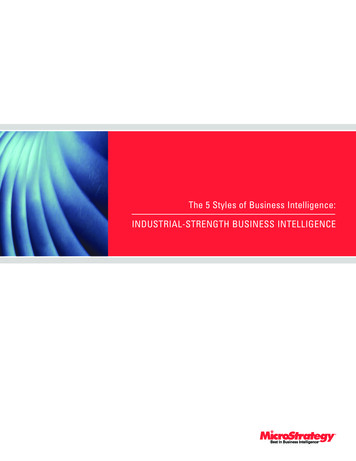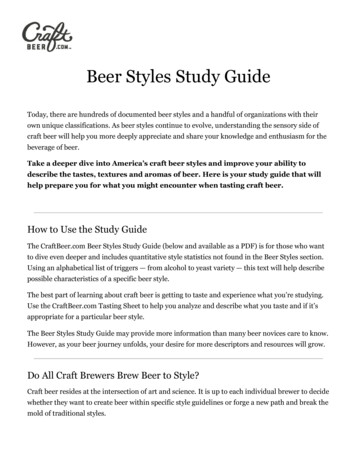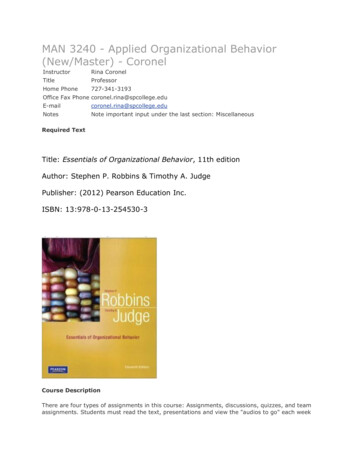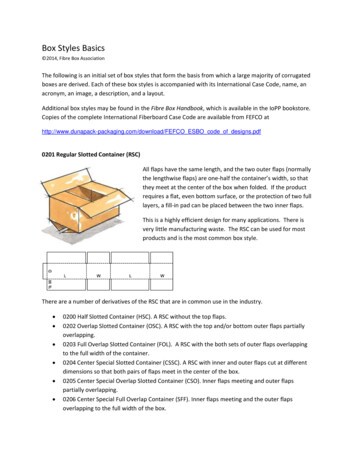
Transcription
The 5 Styles of Business Intelligence:INDUSTRIAL-STRENGTH BUSINESS INTELLIGENCE
The 5 Styles of Business Intelligence:INDUSTRIAL-STRENGTH BUSINESS INTELLIGENCEA White Paper Prepared by MicroStrategy, Inc.
TABLE OF CONTENTS
51EXECUTIVE SUMMARY2THE 5 STYLES OF BUSINESS INTELLIGENCE2.1 The 5 Styles of Business Intelligence in an Enterprise Application Scenario2.2 Industrial-Strength Business Intelligence Technology is Needed to MeetCompanies’ Growing Requirements for Business Intelligence9113ENTERPRISE REPORTING3.1 Support for All Forms of Enterprise Reports3.2 User-defined Web Reporting3.3 High Throughput Report Production and Distribution3.4 Pixel-perfect and Print-perfect Design Without Any Programming3.5 Enterprise Reporting Summary1920232830324CUBE ANALYSIS4.1 Speed-of-Thought Report Analysis and Manipulations4.2 Cube Sharing with Personalized Views and Security4.3 Automatic Synchronization of Intelligent Cubes’ Data4.4 Ad Hoc Drilling from Summary Data to Transactional Details4.5 Cube Summary Analysis35374041 41425AD HOC QUERY AND ANALYSIS5.1 Parameter-driven Reporting and Guided Analysis5.2 Drill Anywhere Allows Users to Surf the Entire Database, Creating NewAd Hoc Reports Dynamically Through the Drilling Process5.3 OLAP Analysis Against the Entire Database – On the Fly Report Manipulations5.4 Filtering Data Using the Power of Sets5.5 User-defined Data Grouping5.6 Ad Hoc Query and Analysis Summary4546STATISTICAL ANALYSIS AND DATA MINING6.1 Applying Statistics and Data Mining Against the Entire Database andfor All Users6.2 Plug-and-Play Architecture for Custom Analytical Functions6.3 Seamless Integration with Data Mining Tools6.4 Sophisticated Analytic Collaboration with the Relational Databases6.5 Multi-pass SQL Produces Calculations Not Otherwise Possible6.6 Statistical Analysis and Data Mining Summary577REPORT DELIVERY AND ALERTING7.1 Report Distribution Through Any Touchpoint7.2 Self-subscription as well as Administrator-based Distribution7.3 Delivery On-demand, On-schedule or On-event7.4 Automatic Content Personalization7.5 Report Delivery and Alerting Summary6969707172748UNIFIED USER INTERFACE AND UNIFIED BACKPLANE ARCHITECTURE8.1 Single Unified User Interface8.2 Single Unified Backplane7779816134849515253586062636465
EXECUTIVE SUMMARY1The purpose of this paper is to provide a framework for understanding the diverse range of business intelligence (BI) functionality that has evolved in the market over the past 15 years. It is also intended to showthat there is a fundamental shortcoming in most BI tools today because they cannot support the full rangeof BI functionality within a single architecture – leading to excessive costs, excessive delays and excessiveuser dissatisfaction. Finally, this paper describes the MicroStrategy architecture as being the only BI architecture capable of delivering all of the functionality requirements within a single architecture.This paper looks at the historical development of BI applications and BI technology, and concludes thatfive common Styles of BI have evolved during the past decade – each style representing a certain characteristic usage and function by end users. These 5 Styles of BI are:1. Enterprise Reporting – Broadly deployed pixel-perfect report formats for operational reportingand scorecards/dashboards targeted at information consumers and executives.2. Cube Analysis – OLAP slice-and-dice analysis of limited data sets, targeted at managers and others who need a safe and simple environment for basic data exploration within a limited range of data.3. Ad Hoc Query and Analysis – Full investigative query into all data, as well as automated sliceand-dice OLAP analysis of the entire database – down to the transaction level of detail if necessary.Targeted at information explorers and power users.4. Statistical Analysis and Data Mining – Full mathematical, financial, and statistical treatmentof data for purposes of correlation analysis, trend analysis, financial analysis and projections.Targeted at the professional information analysts.5. Alerting and Report Delivery – Proactive report delivery and alerting to very large populationsbased on schedules or event triggers in the database. Targeted at very large user populations ofinformation consumers, both internal and external to the enterprise.This paper shows that most BI technologies today can deliver only a single Style of BI. It shows that companies are increasingly dissatisfied with this limitation because it perpetuates a multiplicity of BI technologies within the enterprise that increases costs of ownership, decreases user acceptance and limits therichness of each BI application.5
6CHAPTER 1Executive SummaryThis paper shows that enterprises today need a BI technology that can support any or all of the 5 Stylesof BI in any combination for any given BI application. Moreover, it argues that the only good architecture for delivering all 5 Styles of BI is one where each Style of BI can be:1. Mixed-and-matched seamlessly for users, where the addition of each new BI Style adds functionality to the users’ existing reports2. Expressed through a single unified user interface to maximize ease of use and user acceptance3. Delivered on top of a single integrated backplane that unifies the metadata, security and userprofiles, ensuring a single version of the truth throughout the enterprise and thus minimizingadministration and maintenance efforts by ITFinally, it shows that MicroStrategy delivers each Style of BI uniquely well and that only theMicroStrategy architecture can deliver all 5 Styles of BI on a single unified backplane and through a single unified user interface. It shows that all other BI technologies are fragmented along Styles of BI, suchthat they impose different user interfaces, different metadata and different security for each Style of BI.
2THE 5 STYLES OF BUSINESS INTELLIGENCESince the early 1990s, BI applications have evolved dramatically and in many directions as companies’access to, and appetite for, information grew exponentially. From operational “green-bar” reports generated by mainframes, to statistical modeling of marketing campaigns, to multi-dimensional OLAP environments for analysts, to dashboards and scorecards for executives – companies began to demand more waysto report on and analyze data. The dramatic expansion of data warehousing combined with the widespread adoption of enterprise applications, such as Enterprise Resource Planning (ERP) and CustomerRelationship Management (CRM), and the overall increase in computer literacy, fueled this exponentialdemand for BI reporting and analysis applications.During this formative period, companies actively discovered many new ways to use their data assets fordecision support, operational reporting and process optimization. And during this era of invention, BItechnology vendors reacted the way software vendors always react to new evolving markets – that is, bybuilding niche software to implement each new pattern of application that companies invented. Thesepatterns of applications resulted in software products centered exclusively on one Style of BI, as follows:1. Enterprise Reporting – Report writers were used to generate highly formatted static reportsdestined for broad distribution to many people.2. Cube Analysis – Cube-based BI tools were used to provide simple slice-and-dice analyticalcapabilities to business managers.3. Ad Hoc Query and Analysis – Relational OLAP tools were used to allow power users to querythe database for any answer, slice-and-dice the entire database and surf down to the lowest levelof transactional information.4. Statistical Analysis and Data Mining – Statistical and data mining tools were used to performpredictive modeling or to discover the cause-and-effect correlation between two metrics.5. Report Delivery and Alerting – Report Distribution engines were used to send full reports oralerts to large user populations based on subscriptions, schedules or threshold events in the databases.9
CHAPTER 2The 5 Styles of Business IntelligenceAt this point in time, most leading enterprises have purchased many different BI tool sets from many different vendors – with each tool targeted at a new BI application and each tool delivering user functionality focused on only one of the Styles of BI.One way to look at these different Styles of BI is to place them in a two-dimensional space (Fig. 1) wherethe vertical axes represents the sophistication and interactivity of the analytical processes and the horizontal axis represents scale, or the size of the user population. We can then locate each of the 5 Styles of BIin a region on the grid, as we see in the figure below.INCREASING ANALYTIC SOPHISTICATION & USER INTERACTIVITY10 Advanced Analyses Hypothesis Testing Predictive AnalysisStatistics &Data MiningAd-Hoc Query& AnalysisCubeAnalysis Canned and Parameterized Reports Ad Hoc Query Generation and Drill Anywhere OLAP Functionality Against the Entire Database OLAP Functionality Against a Data Subset (cube) Pre-defined Analytical Views Speed-of-Thought Slice and Dice AnalysisEnterpriseReporting Batch Production of Printed and Web Reports Pixel-Level Control of Field Placement Multi-Report Scorecards and Dashboards Report Subscription and Delivery Exception-based Alerting Information Delivery ServicesReport Delivery& AlertingInformation AnalystsBusiness ManagersAll WorkersExtranetsConsumersINCREASING NUMBER AND RANGE OF USERSFigure 1 – The 5 Styles of Business Intelligence have evolved to support different needs, from advanced professional analysis to basic information consumption.The most sophisticated and interactive Styles of BI are used by relatively small groups of users consistingof information analysts and power users, for whom data and analysis are their primary jobs. Less interactive Styles of BI deliver basic data and results that are applicable to very large user populations rangingfrom senior executives all the way to staff personnel.Leading organizations have recognized the benefits of putting information into the hands of all theiremployees, regardless of job title or function. Only the MicroStrategy architecture can deliver all 5 Stylesof BI functionality to each and every user within an enterprise, offering different functionality levels within the 5 Styles of BI tailored for each user.
THE 5 STYLES OF BUSINESS INTELLIGENCE:Industrial-Strength Business Intelligence2.1 The 5 Styles of BI In An Enterprise Application ScenarioIt is generally accepted now that from the CEO to the support staff, every employee of leading organizations analyzes business data to some degree, in some fashion. Their analyses may be deliberate andexploratory, they may be triggered automatically by threshold conditions or they may even be so embedded in everyday systems that their existence as BI per se may not even be recognized. One thing is clear:successful organizations make maximum use of their data assets through BI technology.In the following scenario, a typical set of analyses and responses are used to demonstrate the 5 Styles ofBI in practice.BI Style 1: Enterprise ReportingWhen an enterprise wishes to distribute standard operational reports or financial reports to all stakeholders in the organization, Enterprise Reporting is used. Since the 1950s, corporations have found clearreturns on their investment in operational and financial reporting. Consequently, Enterprise Reporting isthe most widespread Style of BI – ranging from its earliest adoption as mainframe green-and-white banded paper reports to today’s web-based reports.Consider the following scenario. A store manager receives Store Performance reports generated weeklyby the Report Distribution engine. After a review of one such weekly report on store sales, the store manager notices that sales for computer peripherals have dropped off significantly from previous weeks. Sheclicks on her report and immediately drills to another enterprise report, which shows her that the 3 bestselling hard drives are surprisingly underperformingBI Style 2: Cube AnalysisCube Analysis is the Style of BI ideal for basic analysis that can be anticipated in advance. The analysisof sales by region for certain time periods, and the analysis of sales by product and by salesperson, forinstance, could be useful to store managers looking for some underlying details on performance.In our scenario, the store manager digs deeper into the issue by running one of several analysis cubes thathave been pre-built for the store managers. Analysis cubes provide people with a simple and safe environment that lets novice BI users easily conduct first-order analyses to try to uncover root causes. This particular store manager’s analysis cube allows her to compare her store’s sales results against the sales plan,against sales results at other stores like hers, and against previous years’ seasonal patterns.After flipping through various views of the data in her analysis cube, several things become apparent. Thefirst is that most stores seem to be experiencing this same sudden slowdown in sales. The second is thatthis trend will quickly prevent her from achieving her revenue goals for this product category. And third,this downturn is inconsistent with seasonal sales patterns from the last 2 years for this kind of product. Sheconcludes that there is a serious problem here, and that it is a corporate problem not unique to her store.11
12CHAPTER 2The 5 Styles of Business IntelligenceShe forwards a link to this analysis cube to a buyer at HQ , so they can see exactly what she has seen anddelve deeper into the problem.BI Style 3: Ad Hoc Query and AnalysisAd Hoc Query and Analysis is the Style of BI that enables true investigative analysis of enterprise data,down to the transaction level of detail.The buyer at HQ accesses the analysis cube but cannot determine what is happening based solely on predefined comparisons within the cube. The buyer needs to probe many more areas of the database todetermine what is going on, and uses Ad Hoc Query and Analysis techniques to accomplish this.In our scenario, the buyer runs a parameterized, or prompted, report that lets him create an ad hoc reportsimply by answering some initial questions. His prompt answers automatically generate a report of inventory data for North America for the previous 2 months for the specific SKUs in question.He sees that there has been a steady stream of shipments from the warehouses to the stores, but also thata stoppage in warehouse replenishment has caused a depletion of inventory in the warehouses. He concludes that the problem lies somewhere further back in the supply chain. Next, he drills down from theinventory report to a shipping report that indicates all seaborne shipments from Taiwan have beendelayed, affecting the SKUs in question, as well as some other SKUs. He determines that the other SKUslikewise will soon experience a shortfall in sales.He informs the VP of Sales and all store managers of the results of his analysis, and sends the reports tothe marketing department to determine the significance of the shipment delays on the company’s revenueand profits for the quarter.BI Style 4: Statistics and Data MiningStatistics & Data Mining is the Style of BI used to uncover subtle relationships (e.g. price elasticity) andforecast projections (e.g. sales trends), using set theory techniques, statistical treatment and other advancedmathematical functions.In our scenario, an analyst in the marketing department builds a model of the product line’s revenue andgross margins for the quarter as a function of shipment times, pricing and demand. After estimating thefinancial impact of the delayed shipments, the analyst recommends raising the price on the remainingitems in stock to help cover the lost margins. She also recommends some new promotional spending tosubstitute alternative hard drives through a combination of in-store marketing and advertising.BI Style 5: Report Delivery & AlertingA Report Delivery and Alerting engine allows enterprises to distribute vast numbers of reports or messages on a proactive and centralized basis, as well as allowing users to self-subscribe to report distributions.
THE 5 STYLES OF BUSINESS INTELLIGENCE:Industrial-Strength Business IntelligenceReport distribution can be initiated on a scheduled basis, as well as on an event-triggered basis, such as ametric’s value falling below a target threshold.In our scenario, a task force continuously monitors the progress of new sales programs by subscribing toa distribution service that continuously measures sales performance of relevant SKUs, their margin performance and the costs for the new promotions. The service also continuously monitors the inventory levels in the warehouses and alerts all stakeholders as soon as the shipment delays are over, signaling that pricing and promotion should return to normal. Together, the team is able to make intelligent decisions,respond quickly to changing events, and preserve the company’s exceptional level of performance.Scorecards &Enterprise ReportsCube AnalysisAd Hoc Analysis(Drill Anywhere)Statistics & Data MiningReport Delivery & baseΣEventBasedScheduleBasedThresholdBasedFigure 2 – Only the MicroStrategy architecture allows users to move seamlessly from basic operational reports and scorecards, to ever increasing levels of analysis and back again – all through a single unified user interface.2.2 Industrial-Strength BI Technology Is Needed To Meet Companies’Growing Requirements for Business IntelligenceBI Tools Have Proliferated Out of Control within CompaniesToday, most large companies have over a dozen different BI technologies installed and in use somewherein their organizations. There are two reasons for this gross proliferation of diverse technologies. The firstis because the vast majority of BI tools only support a single Style of BI at a time. If a company neededAd Hoc Query and Analysis capabilities as well as Enterprise Reporting capabilities, then at least two toolswould have been purchased. The second reason is because the vast majority of BI technology wasdesigned in such a way that it could only support small department-scale applications. As a result, BI13
14CHAPTER 2The 5 Styles of Business Intelligenceapplications were deployed in isolation and ultimately individual departments felt empowered to choosewhatever BI technology they wanted.Departmental BI Technology Will Be Replaced by Industrial-Strength BI TechnologyMost BI technology vendors reacted to this purchasing behavior by developing departmental BI products– that is, BI technology focused on a single Style of BI, with limited user scalability, limited data scalability and operational characteristics more attuned to casual small-scale operation, rather than the 24x7 mission critical operation expected of real enterprise-caliber systems. (Fig. 3)DEPARTMENTAL BIBI Tool SuitesBusiness Objects, Cognos, Crystal, Actuate12345Single Style BI ApplicationIndustrial-StrengthBusiness IntelligenceENTERPRISE BIAll 5 Styles of BIBI PlatformMicroStrategyAll 5 Styles,Single Platform,Single Interface100s UsersUser Scale1,000s Users10s GBData Scale100s GBDepartmental-Caliber ITEnterprise-caliber IT12345MicroStrategy 7i24 x 7 OperationsMaintainable at ScaleFigure 3 – Only the MicroStrategy architecture was completely rebuilt as an industrial-strength BI architecture designed specifically to serve enterpriseBI requirements.The end result of departmental BI tool limitations and departmental BI purchasing has been the massiveproliferation of islands of BI that we see today. We’ve seen this kind of proliferation of isolated IT islandsbefore. We saw it with departmental email systems, with departmental PC/Macintosh purchases, withdepartmental client-server applications, with departmental office automation systems and with departmental web sites. In all of these prior cases, the departmental aspirations gave way to enterprise aspirations, and the departmental technology gave way to industrial-strength technology. The same will be trueof BI. In technology-forward companies, departmental BI tools are giving way to the only industrialstrength BI platform – MicroStrategy is the only BI architecture that delivers all 5 Styles of BI.The Problem with Multiple BI Tools for Different Styles of BIThere are five macro forces that are obsolescing the “strategy” of isolated departmental islands of BI andthe use of disparate departmental BI tools.Problem 1.Enterprise BI Applications Need to Access More Data and Support More Users –Departmental BI Lacks User and Data Scalability. Most companies have captured the low-hanging
THE 5 STYLES OF BUSINESS INTELLIGENCE:ROI fruit with their current array of departmental BI applications. Based on the almostuniversal success of these applications, companies are now emboldened to take it to the nextlevel. And that means delivering much richerreports and analysis, from much larger pools ofdata and delivered to many more users.Unfortunately, departmental BI tools todaycannot scale to these new levels (Fig. 4). Thevery nature of their underlying architectureprohibits them from analyzing terabytes ofdata and delivering to expanding user bases.Data VolumeIndustrial-Strength Business IntelligenceDiscoverHudson's BayLowe'sGMBest BuyMICROSTRATEGYEnterprise BILexmarkAstraZenecaDepartmental BI250 UsersBritish TelcomUser PopulationCompanies need an industrial-strength BI platFigure 4 – Companies are refocusing their aspirations from departmental BIapplications in favor of achieving greater impact with enterprise BI applications.form designed for scale to replace departmental BI tools designed solely for interface functionality. MicroStrategy is the only server-centric BI architecture that can analyze terabytes of data and support hundreds of thousands of users easily.Problem 2.Inconsistent Versions of the Truth Are Propagating Through the Enterprise – MultipleIslands of BI Result In Multiple Inconsistent Metadata Repositories. Multiple independentislands of departmental BI applications work fine when the number of applications is small. When thereare few applications, there is little overlap in analytical or reporting domains; inconsistencies in data definitions, in metric usage and business model are not readily evident. However when the number of BIapplications achieves a certain critical mass within the enterprise, there is an inevitable overlap in analytical and reporting domains. It becomes inevitable that multiple reports from multiple independent BIapplications present inconsistent information, preventing a consistent version of the truth. As the number of applications increases, these inconsistencies undermine the integrity of all the BI applications.Companies need a BI technology that is built on one central, unified metadata that ensures consistencyacross hundreds of BI applications and the thousands of metrics, attributes and filters that make them up.Only the MicroStrategy architecture can deliver a single metadata across all 5 Styles of BI.Problem 3.Users Are Increasingly Dissatisfied About Being Forced to Use Multiple BI Tools – MultipleUser Interfaces Are Problematic. When the number of BI applications is few, any given person onlyuses one of those applications, and hence only uses the one BI technology associated with that application. As the number of BI applications increases, more and more people will be accessing multiple BIapplications, and hence using multiple different BI user interfaces to view reports and manipulate thosereports. This means that BI users need to learn different ways to do everything, including such common15
16CHAPTER 2The 5 Styles of Business Intelligenceactions as finding reports, running reports, scheduling reports, editing reports, saving reports, sharingreports, answering prompts, sorting the data and pivoting the data. With two different tools, users will facechallenges. With three different tools, users will be reluctant or unable to use the multiple applications.With four or five different tools, this becomes a valid reason for user rebellion. Nonetheless, this is the situation in which most companies are now finding themselves. With the MicroStrategy architecture, allStyles of BI use the same user interface with consistent paradigms for all user actions. There is no additional user training required as people expand their horizons to use more and more Styles of BI.Problem 4.Enterprise BI Applications Require a Richer User Experience Encompassing Multiple Stylesof Business Intelligence – Single-purpose BI Tools Are Unable to Mix-and-Match Styles of BI.Most departmental BI applications employ a single Style of BI. Enterprise Reporting applications arefocused on the distribution of static, data-packed reports. Cube-based BI applications are focused onOLAP slicing-and-dicing of small data sets as with Cube Analysis. Other applications provide free formanalysis of the entire database as with Ad Hoc Reporting and Analysis. However, the scenario describedin this chapter shows that there is really a natural user flow starting with information presentation, to problem isolation, to full investigation, to advanced analysis, to proactive tracking and alerting.Technical boundaries that isolate the Styles of BI are purely artifacts of single purpose Style of BI software technology, and have nothing to do with user preferences or natural application boundaries. Onlythe MicroStrategy BI architecture allows companies to deploy any or all Styles of BI – exactly what theyneed, efficiently when they need it and precisely to the appropriate users.Problem 5.IT Organizations Cannot Afford the Excessive Cost of Managing Multiple BI Technologies–Disparate BI Technologies for Multiple BI Applications Are Burdensome. Finally, IT organizations suffer excessive redundant costs in managing many diverse BI technologies. With multiple BI tools,companies need to train people in the development and operational intricacies of each BI technology.Companies must establish technical support teams to specialize in each capability. Companies must manage contracts with each BI vendor. Companies must go to conferences, user groups and support forumsfor each BI vendor. Companies must coordinate new version upgrades with their versions of databasesoftware, server operating systems, workstation operating systems, browsers, web servers and firewalls.Companies must manually synchronize metadata overlaps between multiple BI technologies – such assecurity, business definitions, metric definitions and user profiles.Only with a single BI architecture can a company avoid all of these redundant costs and efforts. Only theMicroStrategy architecture can deliver all 5 Styles of BI with the enterprise scale of data and user populations, in turn freeing up time, effort and money.The Ideal Architecture for Delivering All 5 Styles of BIThe ideal architecture for delivering all 5 Styles of BI is one that can deliver:
THE 5 STYLES OF BUSINESS INTELLIGENCE:Industrial-Strength Business Intelligence1. Any or all Styles of BI which can be mixed-and-matched seamlessly for the end users,where the addition of each new BI Style adds functionality to the users’ existing reports2. All expressed through a single unified user interface to maximize ease of use and user acceptance3. All delivered on top of a single integrated backplane that unifies the metadata, security anduser profiles, ensuring a single version of the truth throughout the enterprise and thus minimizingadministration and maintenance efforts by ITThe MicroStrategy architecture was completely rebuilt from the ground up from 1996 through 2000 toachieve precisely this range of flexibility, along with unparalleled scalability – all the things that companies need for industrial-strength BI.THE MICROSTRATEGY INDUSTRIAL-STRENGTH BI oStrategy Intelligence ServerRelationalOLAPReport Delivery& AlertingMicroStrategyOLAP ServicesUnified User InterfaceI N T E R F A C EStatistics &Data MiningCubeAnalysisMicroStrategyReport ServicesW E BAd Hoc Query& AnalysisEnterpriseReportingU N I F I E DAnalyticalEngineMicroStrategyNarrowcast ServerEmail / Printers /File ServersIntegrated BackplaneScalable Server-Centric ArchitectureUNIFIED METADATA AND SECURITY No disorientation caused by multiple UIs Only one BI paradigm for users to learnUnified 5 Styles of BI BI applications can exhibit any or all styles of BI All applications behave the same wayUnified Services Backplane Common MetadataCommon SecurityCommon PromptingCommon SchedulingCommon Privilege ControlCommon AdministrationCommon GoverningFigure 5 – The MicroStrategy architecture delivers any or all Styles of BI through a unified user interface and leverages an integrated backplane of unified services.Other BI vendors may appear to offer integrated products because they are bundled under commonnames and marketing umbrellas. These product collections are cleverly marketed as integrated suites,which mislead organizations into believing that they are implementing a single architecture. Only later dothe companies learn that they have purchased a set of disjointed tools of mainly piecemeal acquisitions,which are in fact just “integrated” through a patchwork of bridges, gateways and portals.The MicroStrategy architecture stands alone in the BI market space as the one integrated architecture,built from the ground up to deliver all 5 Styles of BI with the level of scalability and manageability suitable for enterprise BI applications and capabilities.17
ENTERPRISE REPORTING3Enterprise Reporting is designed for information consumers; individuals at all organizational levels andacross all job functions in the enterprise and also include supply chain partn
INDUSTRIAL-STRENGTH BUSINESS INTELLIGENCE A White Paper Prepared by MicroStrategy, Inc. TABLE OF CONTENTS. 1 EXECUTIVE SUMMARY 2 THE 5 STYLES OF BUSINESS INTELLIGENCE 2.1 The 5 Styles of Business Intelligence in an Enterprise Application Scenario 2.2 Industrial-Strength Business Intelligence Technology is Needed to Meet









